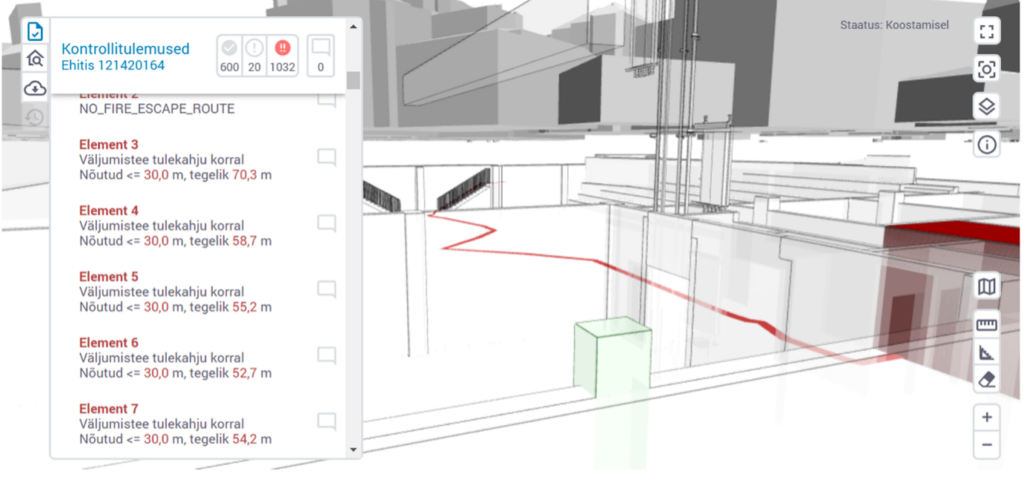Use case EE01- 04.-Theme Fire safety, accessibility and requirements for schools and kindergarten
Estonian pilot for BIM-based building permitting demonstrates how to make use of automated compliance checks in an example of three regulatory use cases:
- Fire safety requirements for the building (use case EE-1);
- Building requirements arise from the special needs of disabled people (use case EE-2);
- Health protection requirements for schools and kindergartens (use case EE-4) that include the following regulations:
All use cases have been implemented in the Estonian national Building Register (EHR). Unfortunately, there is no good overview of EHR in English, but in general, EHR enables the submission of applications for building permits in digital form. So far, the procedure has been document-based, where the applicant fills in given forms using additional tools like national maps and other national databases to streamline the process. But Estonia wishes to move from document-based procedure to BIM-based, and for that reason, we have developed a service in EHR that we call “BIM module”. You can find demo videos about BIM module from here (below, all the screenshots of example compliance checks are also from the BIM module).
For the demonstration we use a BIM of a schoolhouse owned by Tallinn Property Department:

The BIM Module allows the definition of automated compliance checks. Here, in this video you can see an example of some checks defined. From the video, one can see that under the hood of the BIM Module, there is a service called BIMworks (now called BIM Base), where checks have to be defined in JSON. These checks were defined with the help of our ACCORD partner, Future Insight.
The process of defining checks was manual. We skimmed through the regulation and selected clauses that are potential candidates for automated checks. Most clauses were excluded because they were:
- not defining a requirement (general legal explanations; or requirements or responsibilities not related to the building);
- Defining a requirement that is not applicable for projects in the permitting phase;
- Defining a requirement that cannot be quantified (e.g. generally defined attributes like “durability”, “strength”, “contrast”, “not being slippery”);
After selection, we were left with approximately 15-20% of the regulation's full text. We then converted that part into checks in JSON.
Once checks have been defined, these are available for every user in EHR’s BIM module. If the user uploads the model and executes the checks, the results are presented like this:

It shows successful and failed checks and also warnings for cases where there is not enough information to make a final decision (might be a failure or a success). Results have been grouped by regulation and under regulation, grouped by rules. Here is an example of a list of rules in a context of Building requirements arise from the special needs of disabled people (use case EE-2):

And here one can see a list of checks under a single rule:

The result of a check can be visually seen as well. E.g. here is an example where the room in front of an entrance is in compliance with the named regulation, and the required room is shown visually: Here is an example of a failed check, where the distance of a fire exit route is determined to be too long and thus is not in accordance with Fire safety requirements for the building (use case EE-1):
Here is an example of a failed check, where the distance of a fire exit route is determined to be too long and thus is not in accordance with Fire safety requirements for the building (use case EE-1):

This is actually a false negative result because the check is executed for rooms below the ground, and in these cases, the fire exit route should not be checked. But this is a good example of another necessary condition for automated checks and BIM-based permitting in general: the need for “common language”, i.e. common BIM information requirements that help to describe elements and attributes in accordance with current regulations in a rigid unequivocal format readable for the BIM module (or, for any other similar software). Many checks would be impossible to describe without such information requirements because there are often different ways to describe the same information. Furthermore, regulations often do not follow the engineer’s logic in BIM, thus additional attributes are required to express the data needed for regulatory checks. In Estonia we have a common BIM standard called ÜBN, which has been important while developing automated checks for ACCORD use cases.
Although EHR’s BIM module is in its early days in a beta version, it is available for all the users. Today, we already have one BIM-based construction permit for a schoolhouse in process. Therefore, all the automated checks developed in the course of use cases EE-1, EE-2 and EE-4 in ACCORD project are in actual use. Although the application is in progress, the automated checks helped to detect issues within the model already before submittal, thus saving up time that would have been otherwise spent on reviews.

